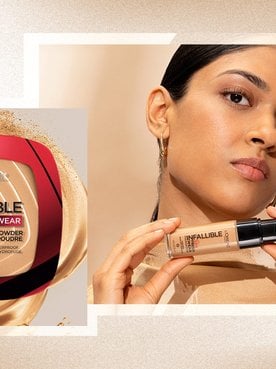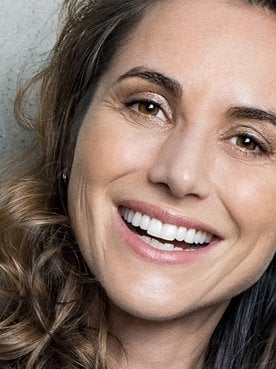If you’re dealing with damaged, dry, or dehydrated hair, your regular conditioner might not be enough to give your strands the moisture and nourishment they need. That’s when knowing how to use a hair mask and choosing the right one for your hair can come in handy. As with any haircare product, the right application technique is a must for reaping the full benefits of your chosen formula: Overnight hair masks have different usage instructions than rinse-out versions, and vice versa. If you want to give your strands some TLC but aren’t sure where to start, keep reading.
Ahead, we’ll explain how to put on a hair mask and answer some common masking-related questions (like: how often should you use a hair mask?) to help you get the most out of your haircare routine. We’re also sharing our favorite hair masks to address different haircare concerns. Find them below.
What is a Hair Mask and What Does it Do?
A hair mask is a type of deep conditioning treatment designed to improve the look and feel of your hair. What does a hair mask do? It’s normally applied to your strands after shampooing to help target specific concerns that your regular conditioner may be unable to address. Damage, dryness, and dullness are just a few common woes that a hair mask can help remedy.
Deep conditioning vs. regular conditioner
A regular conditioner is your hair’s everyday support system—lightweight, fast-acting, and perfect for smoothing, detangling, and adding a touch of shine after shampooing. It works on the surface to seal the cuticle, making your strands look and feel softer and easier to manage.
Deep conditioning, on the other hand, is a targeted treatment. Think of it as rehab for dry, overprocessed, or damaged hair. These formulas go beyond the surface, delivering intense hydration and nourishment that penetrates the hair shaft. Richer and more concentrated, deep conditioners like hair masks are left on for 5 to 30 minutes, depending on your hair’s needs.
Pay attention to your hair. If it feels dry or looks frizzy, you can tell if it needs more than the basics. A hair mask can give it the reset it craves.
Key benefits of a hair mask
Incorporating a hair mask into your weekly routine can visibly transform your hair, how it looks, and feels. Here’s what it delivers:
- Intense hydration
Hair masks deeply moisturize dry strands, leaving them soft, smooth, and easier to manage. Ideal for thick, curly, or color-treated hair that tends to feel rough or brittle. - Damage repair & strengthening
Hair can weaken over time due to heat styling, color, or environmental stress. A hair mask helps strengthen from root to tip, reducing breakage and split ends. - Frizz control & lasting shine
Rich conditioning smooths the hair’s surface, helping tame flyaways and reduce frizz. The result? A sleek, polished finish with noticeable shine. - Protection from heat & styling
Hair masks add a protective layer that cushions strands during blow-drying or flat-ironing, making them less prone to heat damage.
How To Apply a Hair Mask
Now, on to the how-to. Below, we’re sharing a step-by-step guide on how to put on a hair mask to give your strands the care and attention they deserve.
Step 1. Wash your hair
The first order of business on your hair masking journey is washing your hair. If your chosen mask is part of a complete haircare system, we suggest using the corresponding shampoo to help you get the best possible results from the range. If not, try a sulfate-free shampoo suitable for all hair types, like the L'Oréal Paris EverPure Sulfate-Free Glossing Shampoo, which thoroughly cleanses hair without stripping it. You can also pick up a shampoo based on your hair type and concerns.

Step 2. Wring out excess moisture
Once you’ve washed your hair, use your hands to squeeze out excess moisture or do it with a microfiber towel to dry your hair. Your hair shouldn’t be soaking wet when you apply your mask, as the water can dilute the product or cause it to drip off rather than sit in your hair.
Step 3. Apply your hair mask
Next, apply a generous amount of your chosen mask from the mid-lengths to the ends of your hair, avoiding the roots unless the instruction label indicates otherwise. The exact amount of product needed will vary based on your hair length and density, so use the directions on the packaging as a guide rather than a strict rule. If you have thick or curly hair, consider sectioning your strands into four sections to ensure your mask coats them evenly.
Step 4. Let it sit for the allotted time
Some hair masks require up to twenty minutes (perhaps even longer) to work. As always, follow the directions on the mask’s packaging. Washing out a hair mask before the allotted time means your hair may not fully benefit from the mask’s nourishing effects. On the side, leaving a hair mask on too long can make your mane limp, greasy, or even stained (if you opt for a toning mask).
Step 5. Rinse with lukewarm water
Thoroughly rinse your hair mask using cool or lukewarm water after the suggested time is up. To prevent your lengths from looking or feeling greasy, keep rinsing your hair until the texture of your hair mask disappears. Once out of the shower, wrap your hair in a microfiber towel, then let it air-dry or blow-dry it (of course, with a heat protectant).
Which Hair Mask Should You Use?
A hair mask can help improve the look and feel of your mane, but it’s essential to choose the right formula for your hair type, texture, and needs. You can select from purple-tinged formulas to address brassiness, reparative treatments to manage damage, or creamy, hydrating hair masks to restore moisture. For some shopping inspo, read ahead.
Hair mask for dry or damaged hair
L’Oréal Paris Elvive Total Repair 5 Power Restore Multi-Use Treatment
If you’re looking for the best mask for dry, damaged hair, consider the L’Oréal Paris Elvive Total Repair 5 Power Restore Multi-Use Treatment. It’s formulated with caring ingredients and 91 grams of a protein-infused Repair Concentrate. What we love most about this product is its versatility: When you’re not applying it as a hair mask, you can use the formula as a co-wash to help boost hair’s resistance or as a strengthening leave-in treatment.

Hair mask for color-treated hair
L'Oréal Paris Elvive Total Repair 5 Damage-Erasing Balm
To rehydrate color-treated hair, opt for a dedicated hair mask that nourishes your locks while protecting your color. This product deeply conditions to nourish and repair for stronger hair. It is formulated with caring ingredients, featuring almond oil and a sophisticated floral, creamy blend with juicy green notes.
Hair mask for blonde, gray, or highlighted hair
L’Oréal Paris EverPure Sulfate-Free Anti Brass Purple Mask Treatment
If you have bleached or natural blonde hair, consider snagging the L’Oréal Paris EverPure Sulfate-Free Anti Brass Purple Mask Treatment. This violet-tinted mask helps neutralize yellow tones that can occur in lightened hair while deeply nourishing bleached strands. Five minutes is all you need to reap its benefits. (It’s suitable for gray and silver hair, too.)
Shop the Products

How To Use a Hair Mask: Frequently Asked Questions
Now that you’re clued in on how to apply a hair mask, we’ve compiled a list of common queries about the masking process. Below, find answers to more specific questions that you may have about correctly applying a hair mask.
Should you apply a hair mask on wet or dry hair?
You should typically apply a hair mask to damphair. Wet hair is porous, meaning it’s in the best state to absorb the mask´s nutrients. As the excess water might dilute the product, don't apply a hair mask to soaking wet hair. As with any rule, though, there are exceptions—and in this case, a hair mask for dry hair exists and comes in the form of oil masks. Oil-based masks can be applied to dry hair. Water and oil repel, so an oil-based mask likely won’t penetrate the hair shaft well if your strands are wet. Ultimately, it’s best to follow the hair mask´s directions.
How often should you use a hair mask?
How often you use a hair mask generally depends on your hair type, condition, and the kind of mask to be used (so be sure to read the label!). With that said, a good rule of thumb is to observe how your hair responds to your mask and then adjust your usage accordingly. If your hair starts feeling heavy or greasy, you may be applying the deep conditioning treatment too regularly. If your hair remains dry and brittle, consider increasing the frequency or try a more hydrating hair mask.
Do you shampoo after a hair mask?
Unless your mask is a pre-shampoo treatment meant to be applied to hair before washing it, you should use a hair mask after shampooing. There are two reasons for this. First, thoroughly cleansing your hair helps eliminate buildup or other impurities that can prevent your mask from properly absorbing. Second, wet hair is more porous, giving your mask a better chance of penetrating the hair´s fiber. If you ever wondered about using a hair mask before or after shampoo, now you know.
Do you use a hair mask or conditioner first?
A common question is “hair mask before or after conditioner?” In most cases, you should use a hair mask before conditioner. The former aims to give your hair extra moisture, repair, or conditioning beyond what your regular conditioner can provide. As for the latter, it helps seal everything in and gives your hair extra softness, shine, and manageability. It’s worth noting that there are instances where a heavier mask is intended to replace your conditioner, and doubling up on products can backfire by weighing your hair down. Read your mask’s label to gauge whether or not you should skip the subsequent conditioning step.
Can you leave a hair mask on overnight?
You can wear a hair mask while you sleep, but the product must indicate so. It should say it is a leave-in or overnight treatment. These formulas are designed to be left on for extended periods without weighing down your hair. Sometimes, moisturizing and hydrating treatments can work well as overnight hair masks, while reparative masks (like those infused with proteins) can leave hair feeling flat if left in too long. Check your hair mask’s directions and ingredient labels to understand how (and when) to use it.
Next Up: How To Properly Layer Products In Your Haircare Routine
Photo courtesy of L’Oréal Paris







